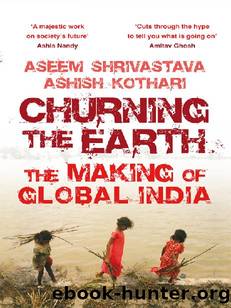Churning the Earth by Aseem Shrivastava

Author:Aseem Shrivastava [Shrivastava, Aseem]
Language: eng
Format: epub
Publisher: Penguin Books Ltd
Published: 2012-05-24T00:00:00+00:00
âRurbanizationâ
The crisis in agriculture is rapidly altering the shape of the countryside. The drive from New Delhi to Meerut in western UP is about seventy kilometres. It used to take under two hours a generation ago. Today it can take up to three or four. The entire routeâpredominantly rural and agricultural earlierâhas become urbanized. It is cluttered with flour and sugar mills; brick kilns; property dealers; tea shops; kirana stores; truck, car and two-wheeler mechanics; bicycle repair shops, and so on. This has led to an explosion of heterogeneous trafficâfrom trucks and buses to bullock carts and cycle rickshaws, not to mention pedestriansâwhich makes the road resemble a city artery rather than a highway.
Does it mean that the entire stretch has become truly urbanized? No. Just a few hundred metres from the highway, the landscape is still entirely rural. Fields are planted with wheat or sugar cane and cattle forage on the fallow lands. More importantly, modern urban infrastructureâcovered drains and hygienic sanitation, public toilets, a steady supply of drinking water, a reliable supply of power, good roads and other civic amenitiesâis conspicuous by its absence in most of the places cars speed by. There is the occasional emblemâwith two children riding a pencilâof the Sarvashiksha Abhiyan (Education for All) visible every now and then in oneâs peripheral vision, signalling the marginal presence of the state schooling system. But itâs not like schools and colleges are exploding all around. Nor are hospitals. As one observer puts it, âThe town is not coming out to the country, as much as the country is reaching out to the town, leaving behind a host of untidy rural debris.â 45
India is not atypical here. The failure of development around most of the Third World is generating what Mike Davis calls a âhermaphroditic landscape, a partially urbanized countrysideâ. It is a form of human settlement not readily classified as either urban or rural. It intermeshes the two in a dense, complex web of transactions which tie urban cores to their environs. Geographer David Drakakis-Smith, writing about Delhi, points out that âextended metropolitan regions ⦠represent a fusion of urban and regional development in which the distinction between what is urban and rural has become blurred as cities expand along corridors of communication, by-passing or surrounding small towns and villages which subsequently experience in situ changes in function and occupationâ. 46
Cities around the world are defined not just by large agglomerations of human population. They are also marked by a way of life which is organized for a somewhat healthy coexistence under such demographic conditions. Thus, it would be much fairer to describe the stretch from New Delhi to Meerut as ârurbanâ, as some people have suggested. A human settlement pattern of such character is hardly uncommon around the country. On the contrary, between the collapsing villages and the overcrowding cities, it is possible to see them becoming the very norm.
The crisis in agriculture and employment is leading to a dramatic change in the nature and meaning of settlement patterns across the country.
Download
This site does not store any files on its server. We only index and link to content provided by other sites. Please contact the content providers to delete copyright contents if any and email us, we'll remove relevant links or contents immediately.
The Lonely City by Olivia Laing(4568)
Animal Frequency by Melissa Alvarez(4148)
All Creatures Great and Small by James Herriot(3986)
Walking by Henry David Thoreau(3681)
Exit West by Mohsin Hamid(3634)
Origin Story: A Big History of Everything by David Christian(3472)
COSMOS by Carl Sagan(3346)
How to Read Water: Clues and Patterns from Puddles to the Sea (Natural Navigation) by Tristan Gooley(3239)
Hedgerow by John Wright(3106)
How to Do Nothing by Jenny Odell(3101)
The Inner Life of Animals by Peter Wohlleben(3099)
How to Read Nature by Tristan Gooley(3077)
Project Animal Farm: An Accidental Journey into the Secret World of Farming and the Truth About Our Food by Sonia Faruqi(3018)
Origin Story by David Christian(2991)
Water by Ian Miller(2950)
A Forest Journey by John Perlin(2915)
The Plant Messiah by Carlos Magdalena(2745)
A Wilder Time by William E. Glassley(2689)
Forests: A Very Short Introduction by Jaboury Ghazoul(2671)
